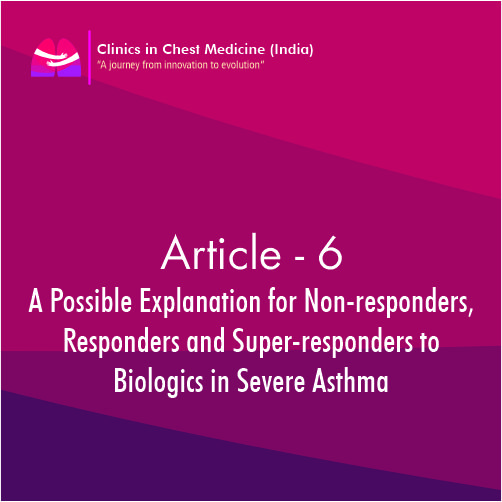A Possible Explanation for Non-responders, Responders and Super-responders to Biologics in Severe Asthma
People with severe asthma are often polysymptomatic with a variable frequency of non-respiratory symptoms. The majority of eligible patients respond well to biologic treatment. Two large studies found that 82–83% of patients are responders to omalizumab and two smaller studies found that 76–77% of patients are responders to mepolizumab.
There are limited explanations for the variable response to biologics. In those patients who meet the criteria for raised eosinophilic or allergic biomarkers, higher levels of baseline biomarkers are associated with better response to a biologic
according to some studies but not others Greater severity, measured by recent past exacerbations also predict better outcome measured by exacerbations. In one study, age, obesity, comorbidities, smoking habits, nasal polyps, and allergic polysensitization were associated with reduced response toomalizumab.
The systemic network-wide inflammation, of which the target molecule is part, could lock the target molecule into an inflammatory state, thereby reducing the effectiveness of the biologic treatment that would otherwise reduce inflammation. Systemic inflammation is an indicator of poorly functioning network, i.e. network dysregulation, and is associated with a number of non-respiratory symptoms. As different target molecules and different inflammatory pathways are embedded in different ways in the overarching inflammatory network, the relationship between biologic and non-respiratory symptoms could be biologic-specific.
If an inflammatory pathway forms part of a wider network, then any therapy will affect not only the inflammatory pathway but also the wider network. It is possible for this effect to be either positive or negative. Glucocorticoids have a wide-ranging
effect on the immune system, suppressing most cytokines, including anti-inflammatory cytokines.20 These wide-ranging effects are more likely to have a dysregulatory effect on a finely tuned network, leading to gradual adaptation that is pathogenic. The finding that systemic steroids often have an initial energizing effect on patients but have long-term widespread adverse consequences is consistent with network functionality. Immediate change to the state of the network caused by the steroid is followed by gradual change to the activation rules (the causal connections between the nodes of the network) leading to adaptation. The long-term adaptation caused by steroids (in contrast to the short-term changes) include psychological symptoms (e.g., depression, fatigue) and somatic symptoms (bone fractures, skin thinning).
All therapies carry some risk of adverse side effects because they affect mechanisms in addition to the target pathway, and it is the effect on these other mechanisms that
could dysregulate the functioning of a biological network. However, because biologics have such a specific effect on the asthma inflammatory pathway, it is possible that these therapies can have a unique effect of reducing pathology in the network. Super-responders to biologic treatment experience benefit because there is a reduction in the distributed pathology of the network, i.e. reduced network dysregulation.Networks are complex systems of massive simultaneous causal connections. Depending on the initial state and depending on its inputs, networks can resolve into a particular
stable state. The state of a network is determined by its historical state, such that different states, or local minima, are possible.24 Change from one local minimum to another (e.g., a lower local minimum) will involve the network moving initially in the opposite direction (Fig. 2).
Let us suppose that networks vary in their level of dysregulation (high dysregulation = poor health, low dysregulation = good health), and that the level of dysregulation can be assessed by the number of non-respiratory symptoms. Let us suppose further that the network can adapt as a function of its inputs, therapeutic or pathogenic, so that dysregulation either increases or decreases. If the network is currently in one local minimum, then therapeutic change that leads the network to resolve into another, less
pathogenic local minimum will require the network to move initially in a more pathogenic direction. So, if therapy requires the network to change from one stable state to another less dysregulated state, then there should be an initial increase in non-respiratory symptoms before those symptoms reduce below the original level.







